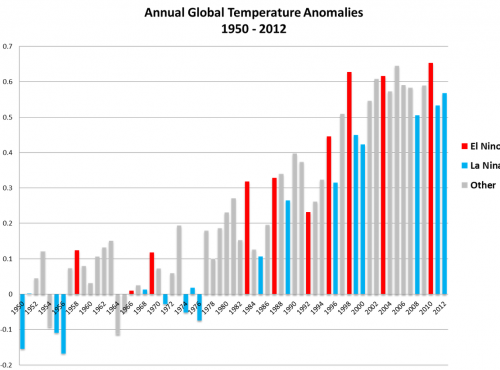 |
| Reviews and Templates for Expression We |
2012 Global Temps Rank in Top 10 Hottest On Record
NASA and NOAA independently keep track of Earth’s surface temperatures, and their records, along with other datasets all show a clear global warming trend during the latter half of the 20th century. Studies show this due in large part to manmade emissions of heat-trapping greenhouse gases, such as carbon dioxide.
Based on NOAA’s numbers, anyone younger than 36-years-old has never experienced a cooler-than-average year on the planet, since the last such year occurred in 1976. The global annual temperature has increased at an average rate of 0.11°F per decade from 1880 to 2012, NOAA said, with the rate of increase accelerating in recent decades, to an average of 0.27°F per decade during the past 50 years. Including 2012, all 12 years during the 21st century have been among the 14 warmest on record, and only one year — 1998 — during the 20th century was warmer than 2012.
According to NASA, with the exception of 1998, the nine warmest years in their 132 years of record keeping have occurred since 2000, with 2010 and 2005 ranking as the hottest years on record.
"One more year of numbers isn't in itself significant," NASA climatologist Gavin Schmidt said in a press release. "What matters is this decade is warmer than the last decade, and that decade was warmer than the decade before. The planet is warming. The reason it's warming is because we are pumping increasing amounts of carbon dioxide into the atmosphere."
Although global temperatures have continued to increase when viewed over longer time periods, there remains considerable year-to-year variability due to natural climate fluctuations, such as La Niña and El Niño events, which can help decrease or increase global temperatures even further.
During the past decade, the rate of global warming has slowed in response to natural variability and changes in manmade pollution, said James Hansen, the director of NASA’s Goddard Institute for Space Studies.
Hansen said the prevalence of La Niña conditions during this period, and an increase in global particulate pollution, most likely account for any apparent slowdown in warming. Particulates, such as sulfate aerosols from burning coal, can mask some of the warming influence of greenhouse gases, and increased air pollution in developing countries such as China and India has boosted particulate pollution in recent years, Hansen said.
However, if the past two years are any indication, the manmade global warming signal may now be powerful enough to largely overcome the short-term cooling influences of a La Niña.
Global surface temperature anomalies shown along with El Nino and La Nina years.
Click to enlarge the image. Credit: NOAA.

During the first three months of 2012, La Niña conditions were present in the equatorial tropical Pacific Ocean, with cooler-than-average sea surface temperatures helping to hold down global temperatures. However, 2012 wound up besting 2011 for the warmest La Niña year on record. In addition, global average ocean temperatures also set a record for the warmest La Niña year.
The warmest year in NOAA’s dataset, 1998, was an El Niño year, when unusually warm sea surface temperatures in the tropical Pacific added to the warming already taking place from the influence of greenhouse gases. The climate has continued to warm since 1998, and the consequences of that warming are becoming increasingly apparent. A new federal assessment of climate change impacts on the U.S. found that climate change is already having a wide range of negative impacts around the country, including longer lasting and more frequent extreme heat events and heavy precipitation events.
In 2012, the U.S. had its warmest and second-most extreme year on record, and Arctic sea ice melted to record low levels. Between March 18 and September 16, 4.57 million square miles of Arctic sea ice melted — the largest ice loss of any melt season on record. Meanwhile, Antarctic sea ice extent hit the largest level on record, which is consistent with climate change projections that show the Antarctic should respond to global warming differently than the Arctic, due to the many geographical distinctions between the two poles and differences in ocean and atmospheric circulation in these areas.
Northern Hemisphere snow cover extent in December 2012 was the largest on record, and snow cover during the winter of 2011-12 was also above average. However, spring snow cover extent has been declining in a trend that scientists have linked to manmade climate change and the loss of Arctic sea ice. While winter Northern Hemisphere snow cover has grown at a rate of about 0.1 percent per decade, spring Northern Hemisphere snow cover has shrunk by about 2.2 percent.
Most parts of the world experienced warmer-than-average annual temperatures, including much of North and South America, most of Europe and Africa, and western, southern, and extreme northeastern Asia. Much of Alaska, far western Canada, central Asia, the eastern and equatorial Pacific, and areas of the Southern Ocean, among others, were cooler than average.
While 2012 saw near-average precipitation across the globe, there were many precipitation extremes that inflicted a heavy toll in terms of their death toll and economic impact. Major drought occurred in the U.S., eastern Russia, Ukraine, and Kazakhstan, as well as in northeastern Brazil. A wetter-than-average rainy season in western and central Africa affected 3 million people across 15 countries from July to October. And in the U.K., conditions swung from record dryness in March to record wetness in April, NOAA said.
|
|
|
|
Copyright 2011 Energy and Technical Services Ltd. All Rights Reserved. Energyts.com |